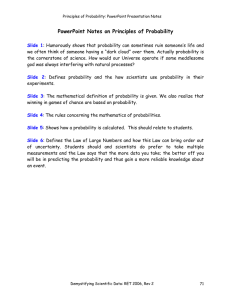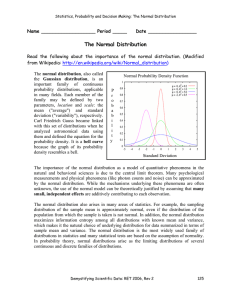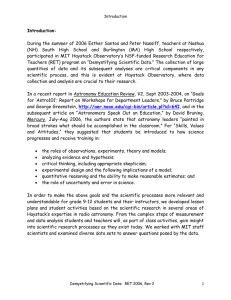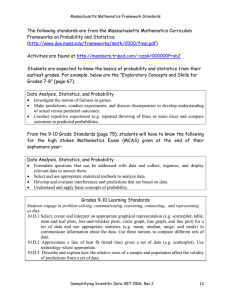The Law of Large Numbers I
advertisement
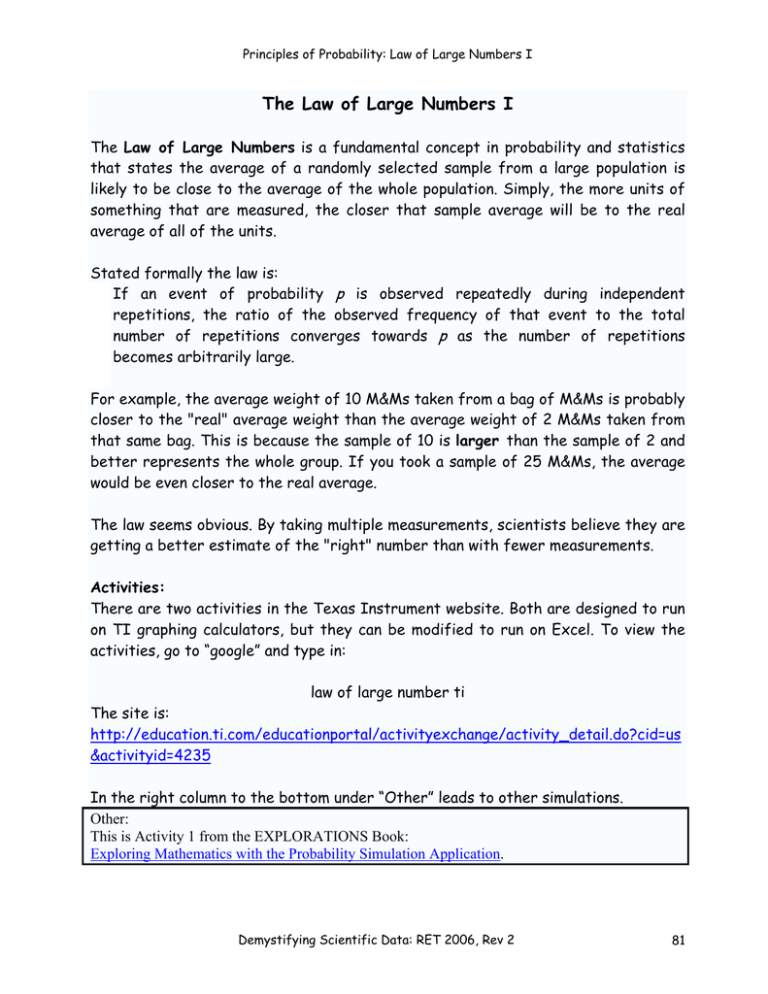
Principles of Probability: Law of Large Numbers I The Law of Large Numbers I The Law of Large Numbers is a fundamental concept in probability and statistics that states the average of a randomly selected sample from a large population is likely to be close to the average of the whole population. Simply, the more units of something that are measured, the closer that sample average will be to the real average of all of the units. Stated formally the law is: If an event of probability p is observed repeatedly during independent repetitions, the ratio of the observed frequency of that event to the total number of repetitions converges towards p as the number of repetitions becomes arbitrarily large. For example, the average weight of 10 M&Ms taken from a bag of M&Ms is probably closer to the "real" average weight than the average weight of 2 M&Ms taken from that same bag. This is because the sample of 10 is larger than the sample of 2 and better represents the whole group. If you took a sample of 25 M&Ms, the average would be even closer to the real average. The law seems obvious. By taking multiple measurements, scientists believe they are getting a better estimate of the "right" number than with fewer measurements. Activities: There are two activities in the Texas Instrument website. Both are designed to run on TI graphing calculators, but they can be modified to run on Excel. To view the activities, go to “google” and type in: law of large number ti The site is: http://education.ti.com/educationportal/activityexchange/activity_detail.do?cid=us &activityid=4235 In the right column to the bottom under “Other” leads to other simulations. Other: This is Activity 1 from the EXPLORATIONS Book: Exploring Mathematics with the Probability Simulation Application. Demystifying Scientific Data: RET 2006, Rev 2 81 Principles of Probability: Law of Large Numbers I The sum of two dice is shown in the table below: 1 2 3 4 5 6 1 2 3 4 5 6 7 2 3 4 5 6 7 8 3 4 5 6 7 8 9 4 5 6 7 8 9 10 5 6 7 8 9 10 11 6 7 8 9 10 11 12 1 2 3 4 5 6 7 8 9 10 11 There are 6 x 6 = 36 combinations. Rolling a 2 occurs only 1 time and has odds of 1÷36 = 0.02777 = 2.77%. Rolling a 7 occurs 6 times or 6÷36 = 1÷6 = 0.1667 = 16.7%. The table below gives the complete probabilities. A 2 3 4 5 6 7 8 9 10 11 12 B =1÷36 =2÷36 =3÷36 =4÷36 =5÷36 =6÷36 =5÷36 =4÷36 =3÷36 =2÷36 =1÷36 Probability 0.0385 0.0556 0.0833 0.1111 0.1389 0.1667 0.1389 0.1111 0.0833 0.0556 0.0385 Percent 3.85 5.56 8.33 11.11 13.89 16.67 13.89 11.11 8.33 5.56 3.85 To run this simulation on Excel, go to Excel. 1. Enter the following, starting at box A1, enter the first two columns in the table directly above. For example, A1 should have “2”. B1 should have “=1÷36”. 2. At the top row, select “Tools” 3. Select“Data Analysis” 4. Choose “Random Number Generator” and hit “OK”. 5. Number of Varables: 6 6. Number of Random Numbers: 6 7. Distribution: Discrete 8. Value and Probability Range: Click on the red arrow in the box, and drag over the box you did in #1. It should read: A$1$:B$11$ 9. Output range: Click on the red arrow and select A15, it should read: A$15$ 10. Click “OK.” This will give you 36 readings. Demystifying Scientific Data: RET 2006, Rev 2 82 Principles of Probability: Law of Large Numbers I Now run a Histogram to separate and select show the readings. 1. From the top, select “Tools” and “Data Analysis” 2. Choose “Histogram” 3. Input Range: Click on the red arrow and drag over the values you simulated. It should read: A$15$:F$20$ 4. Bin Range: Click on the red arrow an drag over the numbers 2 to 12 in column A. It should read A$1$:A$11$ 5. Output Range: Click on the red arrow and click on M1. It should read M$1$ 6. Check off “Chart Output” 7. Click “OK.” 8. Drag over the frequency numbers, N2 to N12, and copy them to column D1. Now do 36 x 36 = 1296 simulations. In the Random Number Generator change the Number of Variables and Number of Random Numbers to 36 in the first two rows and click “OK.” Now obtain the histogram as above. The complete data set should already be selected. If not, drag over the complete data set. It should read $A$15:$AJ$50 Histogram Frequency 250 Frequency 200 150 100 50 0 2 3 4 5 6 7 8 9 10 11 12 Bin Obtain a good histogram and copy it for your report. To get rid of the “More” column, select “Source Data” and change both endings from $13 to $12. Now copy the frequency numbers for the 1296 run into column G1. Your Excel sheet should look like the sheet below. Demystifying Scientific Data: RET 2006, Rev 2 83 Principles of Probability: Law of Large Numbers I A 2 3 4 5 6 7 8 9 10 11 12 B 0.027778 0.055556 0.083333 0.111111 0.138889 0.166667 0.138889 0.111111 0.083333 0.055556 0.027778 C D 1 3 3 6 5 5 5 2 1 3 2 E F G 45 70 97 151 179 223 174 145 104 73 35 H I M N Bin Frequency 2 3 4 5 6 7 8 9 10 11 12 More 45 70 97 151 179 223 174 145 104 73 35 0 Calculate the probabilities and compare them with the theoretical given in column B. 1. In column E1 type “=D1/36” and ”Enter”. Then click on Box E1 and go to the lower light hand corner until you see a large “ +”. Now drag it down to see the entire probabilities. 2. Do the same for column H1 except use 1296 instead of 256 (=G1/1256). What would happen if you took 36 x 1296 = 46656 rolls? Try it. Change Number of Random variables to 1296. Run the Histogram, dragging over the complete data set. Find the probabilities dividing the frequency by 46656. Sample results are shown on the next page. Demystifying Scientific Data: RET 2006, Rev 2 84 Principles of Probability: Law of Large Numbers I Sample Results: B 0.027778 0.055556 0.083333 0.111111 0.138889 0.166667 0.138889 0.111111 0.083333 0.055556 0.027778 Theory C D 2 3 3 3 8 4 2 2 4 2 3 E 0.055556 0.083333 0.083333 0.083333 0.222222 0.111111 0.055556 0.055556 0.111111 0.055556 0.083333 Based on 36 F G 36 75 125 145 172 192 186 141 113 68 43 H 0.028662 0.059713 0.099522 0.115446 0.136943 0.152866 0.148089 0.112261 0.089968 0.05414 0.034236 Based on 1296 I Histogram J 1214 2490 3711 4968 6263 7554 6318 5126 3819 2515 1238 K 0.02602 0.053369 0.07954 0.106481 0.134238 0.161908 0.135417 0.109868 0.081854 0.053905 0.026535 Based on 46656 L M N Bin Frequency 2 3 4 5 6 7 8 9 10 11 12 1214 2490 3711 4968 6263 7554 6318 5126 3819 2515 1238 More 0 Frequency 8000 7000 Frequency 1 2 3 4 5 6 7 8 9 10 11 A 2 3 4 5 6 7 8 9 10 11 12 6000 5000 4000 3000 2000 1000 0 2 3 4 5 6 7 8 9 10 11 12 Bin Demystifying Scientific Data: RET 2006, Rev 2 85 Principles of Probability: Law of Large Numbers I Name ______________________ Period _____ Date_________________ Law of Large Numbers I Include the histograms and data tables in your report. 1. Compare the probabilities with the number of trials. As the number of trials gets larger from 36 to 1296 to 46656, what happens? 2. Explain how your results demononstrate the validity of the law of large numbers. 3. Compare and combine the entire classes’ values for the 256 rolls. If you had 12 teams doing it, it would give you 3072 trials. Predict the outcome. Does the entire classes result agree with your predictions? 4. Consider the probabilites in these models: Lottery, Russian roulette (1 to 6 on the “wheel”) and flipping 3 coins. Do you think that the Law of Large Numbers applies to these probability situations as well? Demystifying Scientific Data: RET 2006, Rev 2 86 Principles of Probability: Law of Large Numbers I 5. Why do scientists like to take as many measurements as possible? Answer the following two extensions from the TI website. 6. Considering the steps and explorations in this activity, what is your response to the question, “How many times must an experiment involving a fair model be repeated before you can reliably determine the probability of any outcome?” That is, how large is “large” in the Law of Large Numbers? 7. Imagine that you rolled the die as many times as the cumulative number of rolls done by the class. (For example, if all 25 students roll a die 1,020 times, then the total number of rolls is 25 x 1020 = 25,500 times.) Do you think the bar graph of the data would look like the one that represented the class result? Go ahead and roll the die the same number of times as your class to verify your answer. Demystifying Scientific Data: RET 2006, Rev 2 87 Principles of Probability: Law of Large Numbers I Demystifying Scientific Data: RET 2006, Rev 2 88
